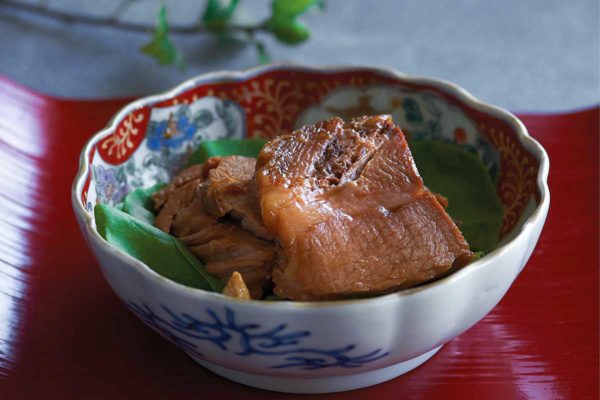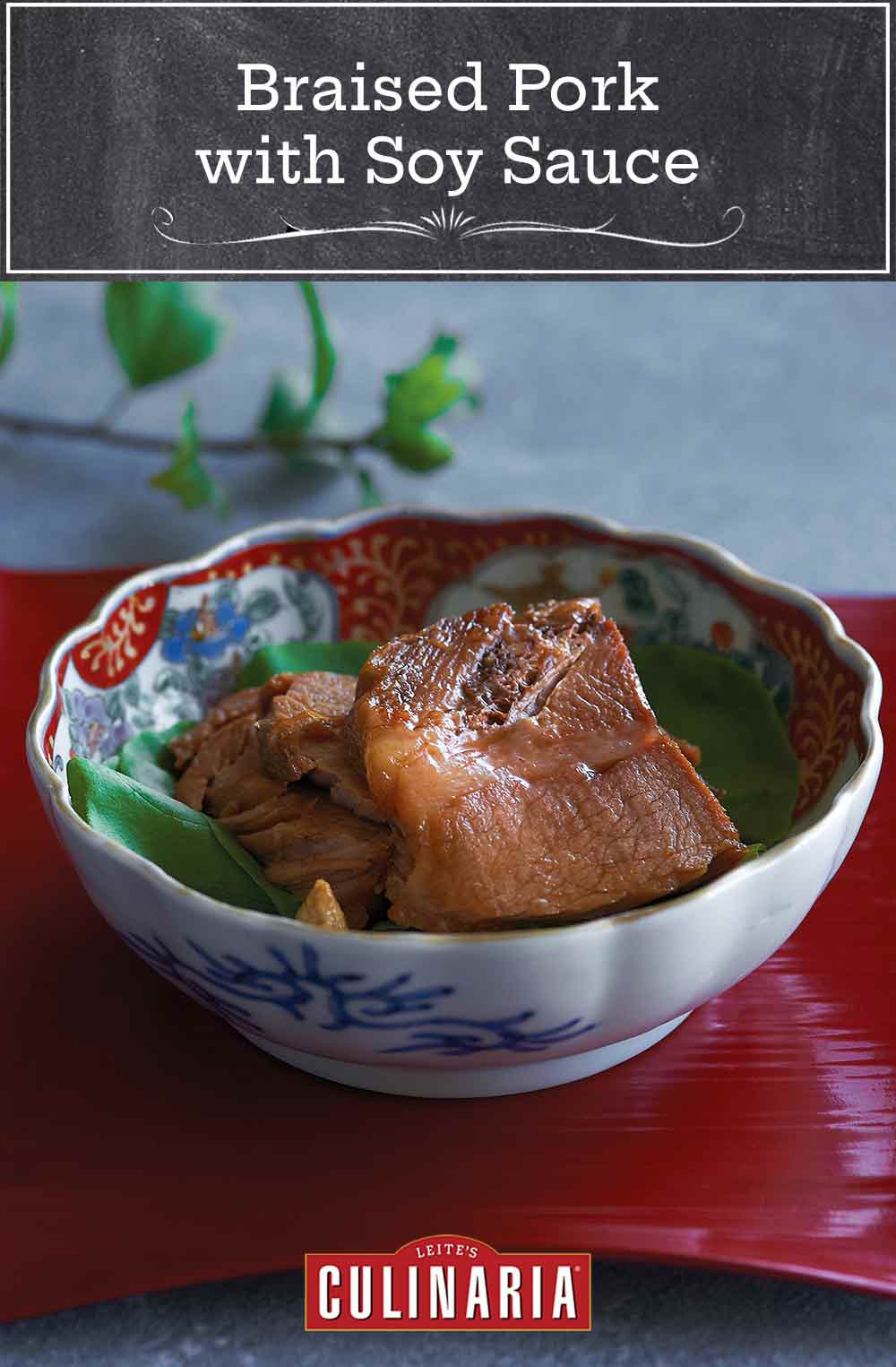
Ramen joints in Japan serve noodles with slices of pork braised in soy sauce and sugar, known as nibuta. When my daughters were younger, they begged me to cook this dish. Listening to a pot of pork simmering over low heat is a great way to enjoy a rainy day. Thin slices of braised pork taste superb atop warm rice and are also good in a sandwich. Actually, the flavor of the pork shoulder improves as it sits, so this is a good dish to make in advance. For extra pretty results, you can roll the pork shoulder and truss it with twine before adding it to the pot. The slices will be very even and attractive.–Rika Yukimasa
What is the best pork for braising?
This recipe calls for pork shoulder and rightly so. Braising pork is an easy way to get a lot of delicious flavor without a lot of hands-on work. The best cut of pork for braising is called a pork butt or a Boston butt. Some grocery stores often label this as a pork shoulder. Boston butt comes from high on the hog, above the shoulder blade. It has lots of juicy, marbled fat, which lends itself well to juicy, slow-cooked meat. Braised pork is a beautiful thing.
Want to save this?

Braised Pork with Soy Sauce
Ingredients
- 6 cups water
- 1 cup cooking sake
- 1/2 cup soy sauce
- 1/2 cup granulated sugar
- 1/4 cup mirin
- 2 tablespoons honey
- 6 quarter-sized slices ginger
- 3 pounds pork shoulder
Instructions
- In a large heavy-bottomed pot over medium heat, combine the water, sake, soy sauce, sugar, mirin, honey, and ginger. Stir until the sugar dissolves, then add the pork to the pot.
- When the liquid in the pot starts to boil, lower the heat to maintain a gentle simmer, cover the pot with a tight-fitting lid, and braise for 2 hours.
- Turn off the heat and let the meat cool in the liquid for at least 1 hour.
- Remove the meat from the liquid and slice it. Place the slices on a large plate. Serve the remaining braising liquid on the side.
☞ TESTER TIP: Refrigerate the cooked and cooled pork overnight before slicing if you want to get perfect slices.

Explore More with AI
Nutrition
Nutrition information is automatically calculated, so should only be used as an approximation.
Recipe Testers’ Reviews
This recipe may cause your ramen consumption to go up. Whether that’s a good or bad thing is debatable. Adding slices of this braised pork with soy sauce will level up your ordinary packaged ramen, getting you a little closer to the restaurant experience. This is one of those recipes where the outcome to effort ratio is so high there’s no reason to not try it out.
The hardest part was waiting the 2 hours for the pork to braise, but the house will fill with an amazing aroma to compensate. While some of the ingredients may not be something you normally have in your pantry, it is worth investing to get them as you will find yourself wanting to make it again.
Braising is my favorite kind of cooking, and this dish didn’t disappoint. This braised pork with soy sauce was meltingly tender, and I loved the sweet and salty interplay of the flavors. It did taste even better the following days (which is true of so many braised dishes and one of the reasons I love them), and I didn’t get tired of it, especially since it was easy to think of new sides and flavors to pair it with.
We had it the first night with rice and some of the braising liquid (not much, because it was salty – I used regular sodium soy sauce) and some sautéed bok choy. The next night, we paired it with egg noodles and wilted spinach, and the following day, I really enjoyed the pork thin-sliced as a sandwich filling.
The only change I’d make next time is to use more ginger. Otherwise, I thought this was a winning recipe, and while of course you have to let the pork cook for a few hours, it was incredibly fast and easy to prepare. I can imagine trying this in an Instant Pot as well. Very versatile recipe, and I’ll definitely be making this again soon.
I think this is one of the most versatile recipes for pork shoulder. I was excited to make it as it was on special at my local grocery store and I was able to cut off a large hunk to freeze. Inexpensive but delicious with leftovers…win-win!
I added more ginger, close to 80 grams instead of 6 coins which weighed 50 grams. I thought my large Le Creuset pot was large enough but 6 cups of water and another 2 cups plus of soy and sake and Mirin was too much and my stove which was spotless yesterday now needs another scrubbing. So, if you use a whole shoulder make sure you have a tall pot with a tight lid.
I used Aloha Soy Sauce and lychee sake as it’s what I had. The broth was just wonderfully fragrant as is simmered. I pulled the meat off the bone and left it in the broth to cool. I had planned to chill it and remove fat from the broth for eating tomorrow night with noodles and crisp stir fry veggies, but it smelled too good not to use it right away, while it was warm.
I pulled the tender braised pork into a few servings and made a sweet cabbage slaw, and toasted some buttered extra-large hot dog buns and smeared them lightly with warmed purchased BBQ sauce. I placed the braised pork with soy sauce on the warmed buns and topped with the slaw. It was very, very good, total comfort food. The pork is so flavorful you don’t need to bury it in sauce, you want the flavor of the meat to shine. I’d use this recipe for anytime I want to serve a group of DIY pork sandwiches with BBQ sauce as a side. I’ve never had a good recipe for pulled pork that had any flavor other than with a BBQ sauce. Easily 10 servings and too much for our small household so I will freeze some packets for a quick lunch.











This recipe was just okay. Combining 6 cups of water with the rest of the braising ingredients creates a very timid braise. I’m not sure how I would adjust this to create something more interesting. I wouldn’t make it again.
We’re sorry to hear that this wasn’t to your liking, Peter. For more flavor, you could try substituting low-sodium broth for the water.